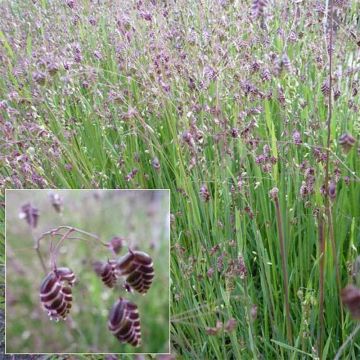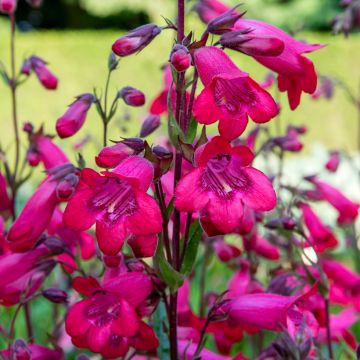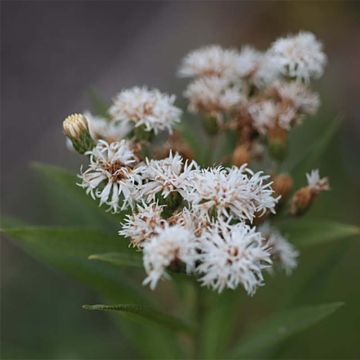Shipping country and language
Your country of residence may be:
Your country of residence is:
For a better user experience on our website, you can select:
Your shipping country:
-
Andorra
-
Austria
-
Belgium
-
Bulgaria
-
Canada
-
Chile
-
Croatia
-
Cyprus
-
Czechia
-
Denmark
-
Estonia
-
Finland
-
France
-
Germany
-
Greece
-
Hungary
-
Iceland
-
Ireland
-
Italy
-
Latvia
-
Lithuania
-
Luxembourg
-
Malta
-
Monaco
-
Netherlands
-
Poland
-
Portugal
-
Romania
-
Slovakia
-
Slovenia
-
Spain
-
Sweden
-
Switzerland
-
United Kingdom
We only deliver seed and bulb products to your country. If you add other products to your basket, they cannot be shipped.
Language:
-
French
-
German
-
Spanish
-
English
-
Italian
My Account
Hello
My wish lists
Log in / Register
Existing customer?
New customer?
Create an account to track your orders, access our customer service and, if you wish, make the most of our upcoming offers.


Briza media Zitterzebra


Briza media Zitterzebra


Briza media Zitterzebra
Briza media Zitterzebra
Briza media Zitterzebra
Common Quaking Grass, Cowquake, Dithering Grass, Doddering Dillies, Didder, Jockey grass, Lady's hair, Maidenhair grass, Pearl grass, Quake grass
The plant never took off ????
Marie Dominique , 20/08/2024
Order in the next for dispatch today!
Dispatch by letter from €3.90.
Delivery charge from €5.90 Oversize package delivery charge from €6.90.
More information
This item is not available in your country.
Schedule delivery date,
and select date in basket
This plant carries a 12 months recovery warranty
More information
We guarantee the quality of our plants for a full growing cycle, and will replace at our expense any plant that fails to recover under normal climatic and planting conditions.
From €5.90 for pickup delivery and €6.90 for home delivery
Express home delivery from €8.90.
Does this plant fit my garden?
Set up your Plantfit profile →
Description
Briza media 'Zitterzebra' is a variety of quaking grass that offers elegant variegated foliage. It always delights us with its joyful heart-shaped purple flowering spikes, dancing at the slightest breeze, but this time, they are carried by variegated foliage. Its fine linear leaves are a vibrant pistachio green bordered with creamy white. This attractive selection can delight lovers of quaking grass, already charmed by its trailing flowering spikes. Enthusiasts of dried bouquets and wild gardens are well acquainted with Briza media, or Quaking Grass. A wonderful hardy perennial, tolerant of difficult conditions, suitable in all gardens, from the wildest to the most contemporary!
Briza media is a creeping stoloniferous herbaceous perennial belonging to the family of Poaceae, like many grasses. Originating in Europe, as well as the western and boreal regions of Asia, this is a particularly hardy and undemanding plant. It grows in small tufts with flat, rough, linear, bluish-green leaves, bordered by bristles. When mature, it will measure 40 to 50 cm (16 to 20in) in all directions, with rapid growth. The foliage is evergreen. In June-July, branched flowers appear, with long, arched capillary branches, each bearing scaly spikes of a characteristic shape, resembling greenish hearts tinged with purple. At maturity, the spikes turn straw blond. The seeds are dispersed by the wind and ensure the species' longevity in gardens and in nature.
In the 'Zitterzebra' variety, the striking foliage is two-tone; green bordered with creamy white. This selection reaches 35 cm (14in) in all directions at maturity.
Hardy to -20° C in well-drained soil, Briza media 'Zitterzebra' is a perfect plant anywhere in the garden, thanks to its easy cultivation and graceful flowering. This grass accompanies flowering and lightweight perennials and annuals, such as Toadflaxes, Penstemons, field daisies, Damask Nigellas, Cosmos, or annual poppies. The dark foliage of Pittosporum tenuifolium 'Tom Thumb', Cotinus 'Royal Purple', or Physocarpus 'Diabolo' in moister soil will enhance its dancing flowers. Plant it along a pathway, in a rock garden, along a terrace, or in a large pot, grouping several plants together. This flower, which can be dyed, is essential in dried bouquets.
Report an error about the product description
Briza media Zitterzebra in pictures


Flowering
Foliage
Plant habit
Botanical data
Briza
media
Zitterzebra
Poaceae
Common Quaking Grass, Cowquake, Dithering Grass, Doddering Dillies, Didder, Jockey grass, Lady's hair, Maidenhair grass, Pearl grass, Quake grass
Cultivar or hybrid
Other Briza
Planting and care
Plant Briza media 'Zitterzebra' in full sun or partial shade, in well-prepared and well-drained soil, even occasionally dry, limestone or poor, rocky or sandy soil. Some watering will be welcome if there is prolonged drought in summer. The plant does not require fertiliser, which could promote foliage development at the expense of flowering, except in really poor soils where well-decomposed compost in spring will be beneficial. A beautiful, low maintenance plant that thrives easily. Cut back the dried foliage in March-April, or in autumn.
Planting period
Intended location
Care
-
, onOrder confirmed
Reply from on Promesse de fleurs
Summer flowering perennials
Haven't found what you were looking for?
Hardiness is the lowest winter temperature a plant can endure without suffering serious damage or even dying. However, hardiness is affected by location (a sheltered area, such as a patio), protection (winter cover) and soil type (hardiness is improved by well-drained soil).

Photo Sharing Terms & Conditions
In order to encourage gardeners to interact and share their experiences, Promesse de fleurs offers various media enabling content to be uploaded onto its Site - in particular via the ‘Photo sharing’ module.
The User agrees to refrain from:
- Posting any content that is illegal, prejudicial, insulting, racist, inciteful to hatred, revisionist, contrary to public decency, that infringes on privacy or on the privacy rights of third parties, in particular the publicity rights of persons and goods, intellectual property rights, or the right to privacy.
- Submitting content on behalf of a third party;
- Impersonate the identity of a third party and/or publish any personal information about a third party;
In general, the User undertakes to refrain from any unethical behaviour.
All Content (in particular text, comments, files, images, photos, videos, creative works, etc.), which may be subject to property or intellectual property rights, image or other private rights, shall remain the property of the User, subject to the limited rights granted by the terms of the licence granted by Promesse de fleurs as stated below. Users are at liberty to publish or not to publish such Content on the Site, notably via the ‘Photo Sharing’ facility, and accept that this Content shall be made public and freely accessible, notably on the Internet.
Users further acknowledge, undertake to have ,and guarantee that they hold all necessary rights and permissions to publish such material on the Site, in particular with regard to the legislation in force pertaining to any privacy, property, intellectual property, image, or contractual rights, or rights of any other nature. By publishing such Content on the Site, Users acknowledge accepting full liability as publishers of the Content within the meaning of the law, and grant Promesse de fleurs, free of charge, an inclusive, worldwide licence for the said Content for the entire duration of its publication, including all reproduction, representation, up/downloading, displaying, performing, transmission, and storage rights.
Users also grant permission for their name to be linked to the Content and accept that this link may not always be made available.
By engaging in posting material, Users consent to their Content becoming automatically accessible on the Internet, in particular on other sites and/or blogs and/or web pages of the Promesse de fleurs site, including in particular social pages and the Promesse de fleurs catalogue.
Users may secure the removal of entrusted content free of charge by issuing a simple request via our contact form.
The flowering period indicated on our website applies to countries and regions located in USDA zone 8 (France, the United Kingdom, Ireland, the Netherlands, etc.)
It will vary according to where you live:
- In zones 9 to 10 (Italy, Spain, Greece, etc.), flowering will occur about 2 to 4 weeks earlier.
- In zones 6 to 7 (Germany, Poland, Slovenia, and lower mountainous regions), flowering will be delayed by 2 to 3 weeks.
- In zone 5 (Central Europe, Scandinavia), blooming will be delayed by 3 to 5 weeks.
In temperate climates, pruning of spring-flowering shrubs (forsythia, spireas, etc.) should be done just after flowering.
Pruning of summer-flowering shrubs (Indian Lilac, Perovskia, etc.) can be done in winter or spring.
In cold regions as well as with frost-sensitive plants, avoid pruning too early when severe frosts may still occur.
The planting period indicated on our website applies to countries and regions located in USDA zone 8 (France, United Kingdom, Ireland, Netherlands).
It will vary according to where you live:
- In Mediterranean zones (Marseille, Madrid, Milan, etc.), autumn and winter are the best planting periods.
- In continental zones (Strasbourg, Munich, Vienna, etc.), delay planting by 2 to 3 weeks in spring and bring it forward by 2 to 4 weeks in autumn.
- In mountainous regions (the Alps, Pyrenees, Carpathians, etc.), it is best to plant in late spring (May-June) or late summer (August-September).
The harvesting period indicated on our website applies to countries and regions in USDA zone 8 (France, England, Ireland, the Netherlands).
In colder areas (Scandinavia, Poland, Austria...) fruit and vegetable harvests are likely to be delayed by 3-4 weeks.
In warmer areas (Italy, Spain, Greece, etc.), harvesting will probably take place earlier, depending on weather conditions.
The sowing periods indicated on our website apply to countries and regions within USDA Zone 8 (France, UK, Ireland, Netherlands).
In colder areas (Scandinavia, Poland, Austria...), delay any outdoor sowing by 3-4 weeks, or sow under glass.
In warmer climes (Italy, Spain, Greece, etc.), bring outdoor sowing forward by a few weeks.















